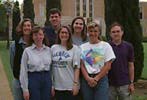 Experiment Group Home Page
Experiment Group Home PageUnfortunately, there was circumstantial evidence for Koyre's argument. First of all, he noticed that the translators of Two New Sciences had translated "I found" into "I found by experiment." Furthermore, Galileo's treatment of motion in the book is entirely mathematical, and his descriptions of the actual experiments are cursory and not terribly useful (as we discovered). Finally, the published works that Koyre had been studying were put together by Antonio Favaro, who did not see the necessity of including all of Galileo's experimental notes.
Thus Koyre published some very influential papers, convincingly arguing that Galileo had not actually used experimentation to arrive at the many conclusions in The Two New Sciences. This new theory was largely backed up by scholars until the 1960's, and it was not until recently that these arguments have been satisfactorily quelled. The rediscovery of the notes Galileo took while he was performing all the experiments in addition to an understanding of why Galileo chose not to emphasize his empirical approach show that Galileo actually performed the experiments he claimed.
Though Galileo is typically seen as a visionary, bringing a new mathematical science of motion to all "ignorant" scholars and clergy in the 17th century; it seems more reasonable to believe that there were philosophical antecedents for his discoveries. Galieo's giant success lay in his new methods for discovery. Galileo spent over twenty years in Venice working on his experiments, coming up with his own revolutionary methods for studying falling bodies. He may have done the Leaning Tower experiment, but determined that the bodies fell too quickly to be accurately measured. To slow them down he invented the inclined plane experiment and the pendulum experiment.
Galileo recognized that one of the weakest parts of Aristotle's theory was the notion of projectile motion. However, since he had grown up within the Aristotelian world view, it took him years of working with his parabola experiment to figure out how projectile motion really occurred. Certainly Galileo could not have just thought up all the radical notions he ended up positing when he came from such a definitively different world view. Probably Galileo did start out with some notion of constant velocity of a ball moving down a plane, but found, as he did his experiments, that his notion had to change to a view of acceleration to accommodate what was actually happening.
Experimental science had no foundations in the 17th century; it wasn't until Robert Boyle in the 1660's when experiment came to be seen as a valid method of discovering truth. Thus, when Galileo was writing his Two New Sciences, he had to present his findings in a way that would be seriously considered by contemporary scholars. Mathematical arguments were generally considered certain. If one could derive all conclusions using only Euclid, then perhaps the conclusions were true. Thus, it is not because he did not perform the experiments that he does not argue in terms of them, it is only because he understood what it would take to convince the people of his time.
Our research and work on Galileo's experiments convinced us that Galileo actually performed his experiments, as he describes difficulties that would only be encountered in the experimental procedure. Also, it is our opinion that he could have easily gotten the accuracy he claims with his methods - the accuracy of our data was close to his claimed accuracy, and we didn't practice as much or take as much data as he did.
Jennifer Lacy
Last revised April 27, 1995